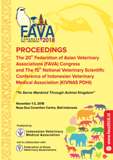FA-11 Seroprevalence and Risk Factors for Bovine Brucellosis in Daerah Khusus Ibukota Jakarta Province, Indonesia
Abstract
Brucellosis in dairy cows caused by Brucella abortus is detrimental to the dairy business because it adversely affects the production and reproduction potential of dairy cows. In Indonesia, annual economic losses due to reproductive disorders including abortion, infertility, sterility, death early of born weak calves and decreased milk production reached 13.8 million US$ (Noor, 2007).
Subsequent serological studies have indicated the presence of bovine brucellosis in some areas in Indonesia such as South Sulawesi, West Timor and DKI. Jakarta. Although infection of goats and sheep in Indonesia has not been documented, brucellosis is likely to be present in these species as well. However, brucellosis in these species is generally caused by Brucella melitensis.
Brucella abortus is endemic in Indonesia. In past three years, the number of brucellosis cases in DKI. Jakarta has increased with more less 501 heads were detected seropositive recently in 91 farms of dairy cattle and 141 out of 899 samples in 2013, 5 out of 178 in 2014 and 58 out of 202 in 2015 samples were positive Brucellosis reported among approximate 2.550 dairy cattle in DKI. Jakarta province respectively. Brucellosis was detected not only in dairy cattle, but also in sheep in DKI. Jakarta Province. Therefore brucellosis still a concern of the Indonesian government.
Population of cattle in Indonesia is more less 16 million. This population comprises of 15.5 million of beef cattle and 0,5 million of dairy cattle distributed in 33 provinces. In Indonesia, eradication activities are accompanied by a vaccination program of infected farms conducted to maintain low level of brucellosis at farm level.
However the implementation of vaccination program is mostly irregular, and therefore the benefits from the vaccination for brucellosis may be hard to assess. In addition, culling accompanied by a compensation scheme has not worked properly, as the amount of compensation disbursed is generally considered insufficient by farmers. This means that not all seroreactors are culled. (Anka et al, 2014).
This situation threatens the cattle population in DKI. Jakarta, especially for DKI. Jakarta Province which has become the source of dairy products such as milk and milk-derived products. Therefore, bovine brucellosis is still one of the targeted diseases that the Indonesian government is trying to eradicate in future.

